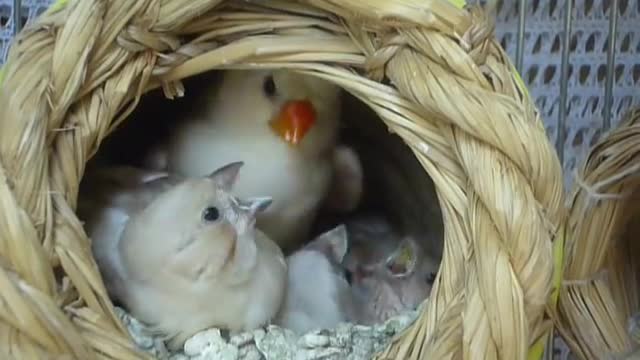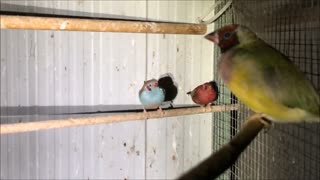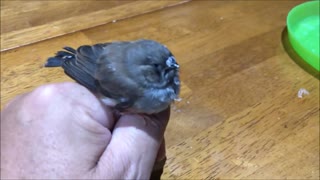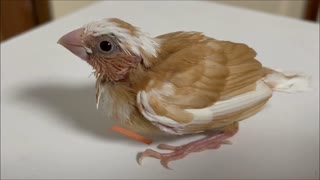Premium Only Content

Finch & finch babies in nest
The true finches are small to medium-sized passerine birds in the family Fringillidae. Finches have stout conical bills adapted for eating seeds and often have colourful plumage. They occupy a great range of habitats where they are usually resident and do not migrate. They have a worldwide distribution except for Australia and the polar regions. The family includes species known as siskins, canaries, redpolls, serins, grosbeaks and euphonias.
The finches have a near-global distribution, being found across the Americas, Eurasia and Africa, as well as some island groups such as the Hawaiian islands. They are absent from Australasia, Antarctica, the Southern Pacific and the islands of the Indian Ocean, although some European species have been widely introduced in Australia and New Zealand.
Finches are typically inhabitants of well-wooded areas, but some can be found on mountains or even in deserts.
The finches are primarily granivorous, but euphoniines include considerable amounts of arthropods and berries in their diet, and Hawaiian honeycreepers evolved to utilize a wide range of food sources, including nectar. The diet of Fringillidae nestlings includes a varying amount of small arthropods.
Finches are the perfect alternative for those wanting a feathered pet but not prepared to take on the challenges of caring for a parrot. Finches don’t talk and are hands-off birds, but they delight their owners with their aerial antics and social interactions with one another.
“Finch” is a loose term to describe one of many (hundreds!) of small passerine birds. The finch species most commonly kept as pets come from the Estrildidae family of finches, like the zebra finch Gouldian finch, owl finch and society finch. Finches are ideal for those wanting a pet bird but not ready to take on the demands of a parrot. They will be content housed in a large flight cage or aviary with other finches. A finch most likely will not be a cuddly companion (although some hand-raised finches, especially zebra finches, have been known to perch on a finger) like a parrot.
Finches need spacious housing, especially since they spend most, if not all, of their time inside their enclosure. These birds should remain fully flighted instead of having trimmed wing feathers. A horizontal cage is a must (as opposed to a vertical cage). Finches are flock animals and thrive when housed with other finches (do not house a finch with a parrot because a parrot can injure a finch). If you house pairs of finches together, be prepared for possible offspring, especially if the finches are provided a nest (small wicker-basket) and nesting material.
-
 0:48
0:48
All Creatures Great and Small Channel
3 years agoBaby Finch
261 -
 0:59
0:59
All Creatures Great and Small Channel
3 years agoCordon Bleu Finch
31 -
 1:07
1:07
All Creatures Great and Small Channel
3 years agoBaby Finch
352 -
 0:28
0:28
All Creatures Great and Small Channel
3 years agoBaby Society Finch
623 -
 2:37:35
2:37:35
TimcastIRL
5 hours agoJFK FILES RELEASED, Shocking Documents Released By Trump DROPPED w/Amber Duke | Timcast IRL
195K152 -

SpartakusLIVE
9 hours agoReturn to VERDANSK w/ StoneMountain64, IcemanIsaac, and Huskerrs
60.5K3 -
 LIVE
LIVE
Hevel Gaming
5 hours ago $1.77 earnedHevel Tries To Conquer Rumble
409 watching -
 51:13
51:13
Man in America
9 hours ago🚨 Big Short 2.0: The SECRET $3.8T Debt Bomb That Could WIPE OUT Pensions & US Economy
44.2K17 -
 14:13:00
14:13:00
MDGgamin
15 hours ago🔴LIVE - JFK Files TODAY!! 2nd Shooter ? - TARKOV & WoW - #RumbleTakeover
29.8K2 -
 4:31:16
4:31:16
Geeks + Gamers
8 hours agoTuesday Night's Main Event
36.6K5